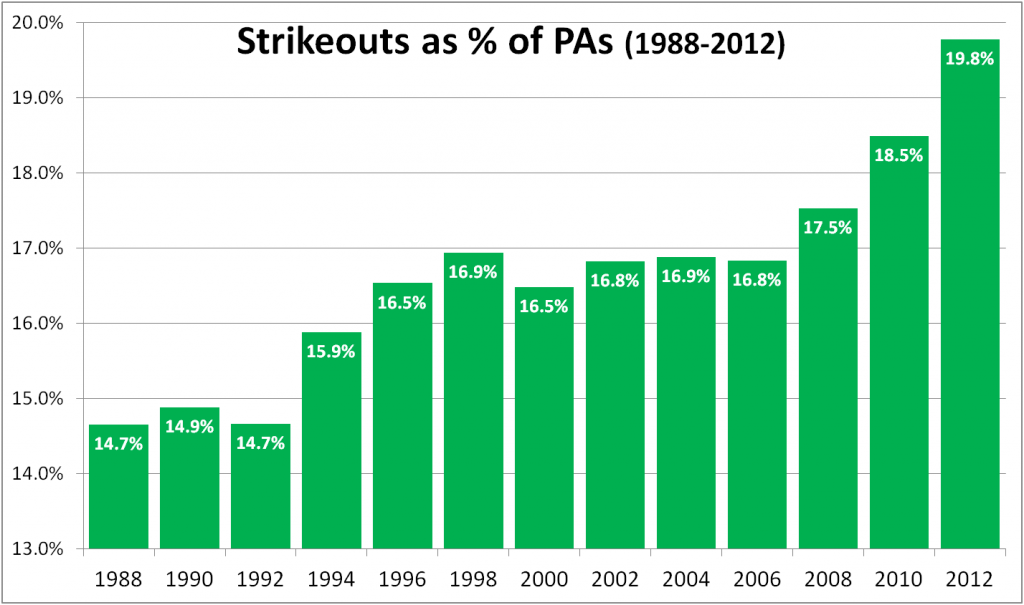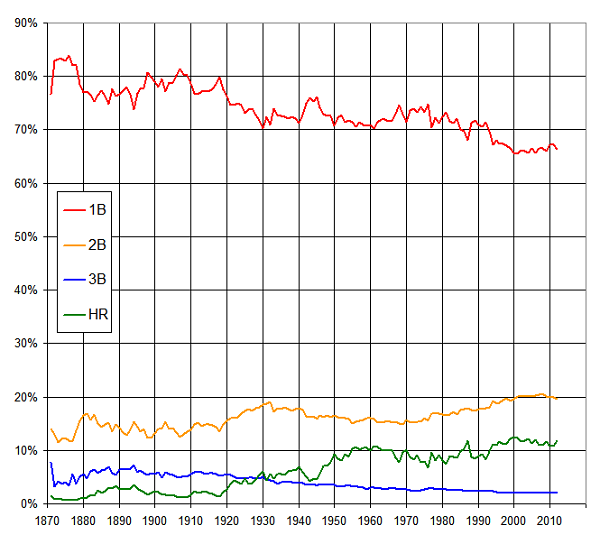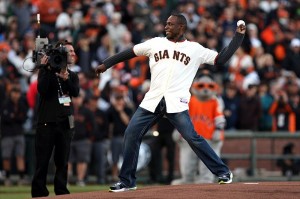The MLB strikeout rate has risen 35% since 1988, climbing from 14.7% of all PAs to 19.8% in 2012. It’s not all the batters’ doing, and I’m not here to berate them, anyway. I just want to look at two basic parts on their side of the K-rate equation. Let’s show the basic rate before we break it down:
Category Archives: Uncategorized
The amazing Darren Oliver @southpawDO28
Darren Oliver has re-signed with the Blue Jays for 2013 and he’ll be coming back for his 20th season in the majors. He’ll be 42 on Opening Day.
Perhaps the most incredible thing about Oliver’s career is that he isn’t simply hanging on into old age. His line for the last 5 years (2008-2012) reads like this: 304 games, 1 start, 314.1 IP, 271 H, 79 BB, 274 K, 2.52 ERA, 175 ERA+.
Take a look at that line again. Basically, he’s been an ace reliever.
Oliver’s last bad season was in 2004. He didn’t pitch in the majors in 2005, but since then has rattled off 7 straight years ranging from good to excellent. Over that period, he’s been worth 10 Wins Above Replacement as a middle reliever.
Just to give you an idea of how valuable Oliver has been, here are the leaders in WAR among non-closing relievers:
| Rk | Player | WAR | SV | G | From | To |
|---|---|---|---|---|---|---|
| 1 | Octavio Dotel | 15.4 | 109 | 752 | 1999 | 2012 |
| 2 | LaTroy Hawkins | 14.1 | 88 | 871 | 1995 | 2012 |
| 3 | Rafael Betancourt | 13.6 | 58 | 603 | 2003 | 2012 |
| 4 | Matt Thornton | 10.4 | 23 | 546 | 2004 | 2012 |
| 5 | Scott Downs | 9.9 | 26 | 496 | 2000 | 2012 |
| 6 | Sean Marshall | 9.4 | 16 | 365 | 2006 | 2012 |
| 7 | Mike Adams | 9.3 | 4 | 358 | 2004 | 2012 |
| 8 | Joaquin Benoit | 9.1 | 13 | 475 | 2001 | 2012 |
| 9 | Jesse Crain | 8.5 | 4 | 494 | 2004 | 2012 |
| 10 | Jeremy Affeldt | 8.4 | 28 | 621 | 2002 | 2012 |
Oliver himself didn’t qualify for this list since he was primarily a starter before his renaissance.
If we look at just 2006-2012, since Oliver has been reborn as a reliever, here are the top WAR totals among non-closing relievers:
| Rk | Player | WAR | SV | G | From | To |
|---|---|---|---|---|---|---|
| 1 | Rafael Betancourt | 11.1 | 52 | 448 | 2006 | 2012 |
| 2 | Matt Thornton | 10.1 | 23 | 472 | 2006 | 2012 |
| 3 | Scott Downs | 10.0 | 26 | 438 | 2006 | 2012 |
| 4 | Darren Oliver | 10.0 | 5 | 410 | 2006 | 2012 |
| 5 | Sean Marshall | 9.4 | 16 | 365 | 2006 | 2012 |
| 6 | Mike Adams | 8.0 | 3 | 299 | 2006 | 2012 |
| 7 | Brad Ziegler | 7.3 | 19 | 323 | 2008 | 2012 |
| 8 | Grant Balfour | 7.1 | 34 | 343 | 2007 | 2012 |
| 9 | Darren O’Day | 7.1 | 2 | 255 | 2008 | 2012 |
| 10 | David Robertson | 6.8 | 5 | 269 | 2008 | 2012 |
Any way you slice it, this guy is among the best middle relievers going into 2013.
What goes around comes around: guys who scored most often when getting on base
I posted this list in the comments to an earlier thread, but it really seems to deserve its own post.
Here are the players since 1901 who scored the highest percentage of time once reaching base (including reaching on error) with a minimum of 4000 career plate appearances.
1 Red Rolfe 48.8% 2 Jack Smith 47.2% 3 Pepper Martin 46.9% 4 Earle Combs 46.5% 5 Tommy Leach 45.3% 6 Joe DiMaggio 45.2% 7 C Granderson 45.2% 8 Ian Kinsler 44.4% 9 Lou Gehrig 44.2% 10 Hughie Critz 44.0% 11 Ray Chapman 44.0% 12 Tom Goodwin 43.7% 13 Babe Ruth 43.7% 14 Tommy Henrich 43.7% 15 C Gehringer 43.5% 16 Chuck Klein 43.4% 17 Kenny Lofton 43.3% 18 Earl Averill 43.3% 19 Alex Rodriguez 43.0% 20 Fred Clarke 42.9% 21 Donie Bush 42.8% 22 Vince Coleman 42.7% 23 F Lindstrom 42.7% 24 Kiki Cuyler 42.6% 25 Bobby Bonds 42.6% 26 Bill Cissell 42.6% 27 Jimmie Foxx 42.6% 28 Pete Fox 42.5% 29 Jimmy Rollins 42.5% 30 Ron Gant 42.5%
This is quite an eclectic group, huh?
The research was sparked by reader kds noticing that Kenny Lofton had a very high percentage, and indeed he clocks in at #17. Some other leadoff-type speedsters make it too, with Bobby Bonds, Vince Coleman, Tom Goodwin(!), Jimmy Rollins, and others. Then there are other guys with a lot of home runs–obviously that’s an automatic 1-for-1 in terms of scoring when reaching base–Babe Ruth, Alex Rodriguez, Jimmy Foxx, etc.
I’m sure there’s a lot more we can glean from this…have at it.
Reliving the hits: how hit distribution has changed in MLB history
Here’s a pretty simple graph showing the breakdown each year of hits distribution.
So, for any given year, this shows the percentage of total hits for that year that were singles, doubles, triples, or homers.
Some observations / conclusions:
- Singles have, understandably, fallen off considerably. At the dawn of the game, they represented more than 80% of all hits but in recent years have been right around two-thirds. 2012’s percentage of 66.4 is among the lowest ever–just slightly above figures between 65 and 66 in the 2000’s.
- Triples increased in the 1880s and 1890s but have declined pretty steadily since except for renaissances in the 1910s and 1970s. The rate has hovered right around 2% for several years now.
- Doubles are quite interesting. You might have expected that they peaked in the late 1990s or early 200s (like homers) but their two peak seasons are actually 2007 and 2008, at 20.4% and 20.5% respectively. Doubles are off a bit in the last couple of years, probably largely because home runs have spiked again.
- Homers took a huge upward turn when Babe Ruth came on the scene, then took subsequent big jumps in the 1940s and the 1990s. They peaked in 2000 at 12.6%, fell as low as 10.8% in 2011 but rebounded last year to 11.8%.
- 1987 shows up again as a really fluke year. Home runs spiked up that year (then back down in 1988) and singles spiked way down (and then back up in 1988).
I wonder what singles will look like 50 years from now. The decline has been remarkably linear so far, losing just about 8/10ths of a percentage point each decade. I’m sure that rate will slow, or else singles will account for fewer than half of all hits by about the year 2206. (Although this is an accurate projection from the data, rest assured that my tongue is planted firmly in my cheek right now.)
Circle of Greats 1964 Ballot
This post is for voting and discussion of the fifth round of voting for the Circle of Greats, which adds players born in 1964. Rules and lists are after the jump. Continue reading
Circle of Greats 1965 Results: Hurt’s So Good
Frank Thomas, The Big Hurt, capped strong showings in each of our COG votes so far with a solid victory, appearing on 52 of 79 ballots cast to earn induction. More on Thomas, and the voting, after the jump. Continue reading
Pitchers Who Bested Barry Bonds
I’ve been staring at my computer for hours, trying to figure out a poetic way to summarize Barry Bonds‘ career. In between bouts of writer’s block, I’ve gawked at his career stats so many times that I’ve memorized them: a batting line of .298/.444/.607, 762 home runs, 688 intentional walks, 514 stolen bases, a 158.1 bWAR.
Bonds is undoubtedly one of the game’s most powerful and feared hitters. Over 22 seasons, 1,224 pitchers helped pave his path to Cooperstown, and I can’t help but wonder how many of those received even a modicum of success against his 1.051 OPS and .435 wOBA.
One and done: the best players to fall off the Hall of Fame ballot after their 1st year of eligibility
With Kenny Lofton receiving a miserable 3.2% of the vote in yesterday’s Hall of Fame balloting, he’s gone from future consideration despite 6 All-Star appearances, 4 Gold Gloves, and 64.9 career WAR (greater than the totals of more than 50 players already enshrined.)
With a hat tip to @phungo2008 for asking the question, here are the players with the highest career WAR totals who fell off the Hall of Fame ballot in their first year of eligibility:
Lou Whitaker (71.4 WAR, 2.9% in 2001) Bill Dahlen (70.9 WAR, 0.4% in 1938) Bobby Grich (67.3 WAR, 2.6% in 1992) Kenny Lofton (64.9 WAR, 3.2% in 2013) Kevin Brown (64.3 WAR, 2.1% in 2011) Willie Randolph (63.0 WAR, 1.1% in 1998) Buddy Bell (61.6 WAR, 1.7% in 1995) Reggie Smith (60.8 WAR, 0.7% in 1988) David Cone (58.8 WAR, 3.9% in 2009) Sal Bando (57.1 WAR, 0.7% in 1987)
A new notes:
- All of these guys fell off the ballot because they didn’t receive 5% of the vote. There are other players with higher WAR totals, such as Ken Boyer and Wes Ferrell, who received less than 5% in their 1st year but didn’t fall off the ballot because the rules were different.
- There are a bunch of 19th-century players, Jim McCormick chief among them, who have enough WAR to qualify but were never listed on any HOF ballot.
- And of course, Pete Rose and Shoeless Joe Jackson would make this top 10 but also have never appeared on any HOF ballot.
Beating a Dead Horse
What hasn’t been written about the 2013 Hall of Fame ballot? You’ve got the law and order folks keeping out Barry Bonds and Roger Clemens, the traditionalists putting in Jack Morris and Dale Murphy, and those of questionable sanity voting for Sandy Alomar, Jr. And let’s not forget the blank ballots. On second thought, let’s try to. That being said, everyone has a voice, regardless of whether or not they are a part of the BBWAA.
That’s where I come in. Player-by-player analysis and commentary after the jump.
Hotter later: Adam LaRoche and 1st-half/2nd-half splits
With the news of Adam LaRoche‘s new deal with Washington, I remembered his well-known history of slow starts and hot finishes. Thanks to B-R’s new batting split finder (beta), we can compare his 1st-half/2nd-half splits to those of other players.




